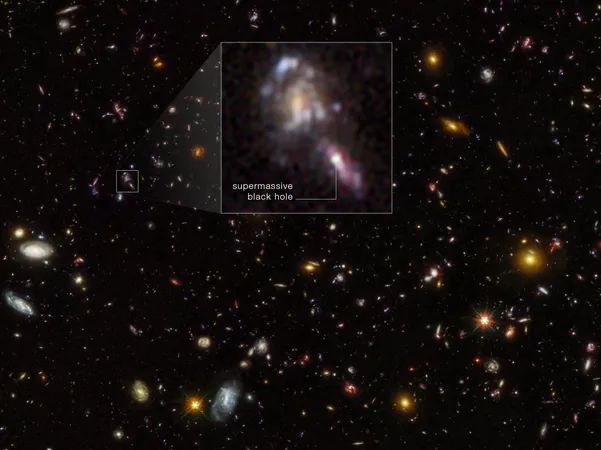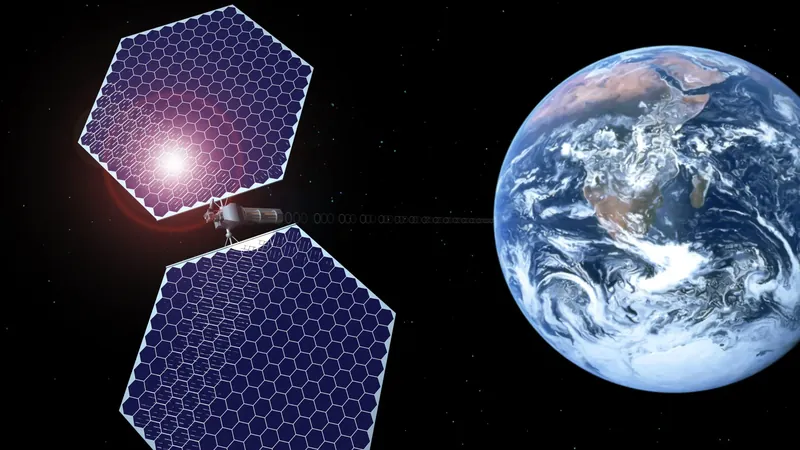
Hubble Discovers Surprising Number of Black Holes in the Early Universe! What Does This Mean for Our Understanding of the Cosmos?
2024-09-17
Author: Wei
Introduction
In a groundbreaking discovery, NASA's Hubble Space Telescope has unveiled a staggering number of black holes that existed shortly after the Big Bang—significantly more than previously thought. Led by an international team with key contributors from the Department of Astronomy at Stockholm University, this research offers new insights into the enigmatic birth of supermassive black holes, which can weigh over one billion times that of our Sun.
Formation of Black Holes
Astrophysicists have long grappled with the formation of the universe's earliest black holes, which emerged just a few hundred million years after the Big Bang. Intriguingly, these colossal black holes are found residing at the centers of many galaxies, revealing the dynamic processes that could allow such massive entities to exist at a surprisingly young cosmic age.
Research Insights
"The findings indicate that many of these black holes may be more massive than we ever thought possible for that time," stated Alice Young, a Ph.D. student at Stockholm University and co-author of the study featured in *The Astrophysical Journal Letters*. "This suggests they either formed with considerable mass or experienced rapid growth."
Importance of Understanding Black Holes
Understanding black holes is crucial, as they play a pivotal role in the evolution of galaxies. However, the complexities surrounding their formation remain largely unknown. By meticulously surveying faint galaxies from this early epoch, the researchers utilized Hubble's advanced capabilities to reveal the prevalence of black holes, marking a significant advancement in observational astrophysics.
Methodology
To achieve this, researchers conducted a time-series analysis by re-imaging specific regions several years apart, allowing them to observe changes in brightness that directly indicate the presence of black holes. Remarkably, this method led to the identification of black holes at a higher frequency than previous techniques had accomplished.
Theories on Black Hole Origin
These new findings imply that some black holes likely originated from the collapse of massive, star-forming clouds during the universe's formative years. Such "pristine" stars, composed primarily of hydrogen and helium, could only have formed in the early universe, unlike later generations of stars that are influenced by the remnants of earlier stellar explosions.
Alternative Hypotheses
Alternative hypotheses for black hole formation also exist, including catastrophic mergers of massive stars within dense clusters, as well as hypothetical primordial black holes that may have formed in the universe's infancy during the immediate aftermath of the Big Bang.
Significance of the Findings
"What we've learned about early black hole formation is critical to understanding galaxy evolution," emphasized Matthew Hayes, the lead author of the study. "By integrating black hole growth models with galaxy formation theories, we can enhance our frameworks, creating a more realistic picture of how these cosmic giants came to be."
Conclusion
This eye-opening research not only challenges previous assumptions about the universe’s formative years but also opens the door for new inquiries into the intricate relationship between black holes and galaxies. As scientists continue to gather data, Hubble's revelations could lead to a transformative shift in our understanding of the cosmos and its vast, mysterious history. Stay tuned as we delve deeper into the universe's most captivating secrets!




 Brasil (PT)
Brasil (PT)
 Canada (EN)
Canada (EN)
 Chile (ES)
Chile (ES)
 Česko (CS)
Česko (CS)
 대한민국 (KO)
대한민국 (KO)
 España (ES)
España (ES)
 France (FR)
France (FR)
 Hong Kong (EN)
Hong Kong (EN)
 Italia (IT)
Italia (IT)
 日本 (JA)
日本 (JA)
 Magyarország (HU)
Magyarország (HU)
 Norge (NO)
Norge (NO)
 Polska (PL)
Polska (PL)
 Schweiz (DE)
Schweiz (DE)
 Singapore (EN)
Singapore (EN)
 Sverige (SV)
Sverige (SV)
 Suomi (FI)
Suomi (FI)
 Türkiye (TR)
Türkiye (TR)
 الإمارات العربية المتحدة (AR)
الإمارات العربية المتحدة (AR)